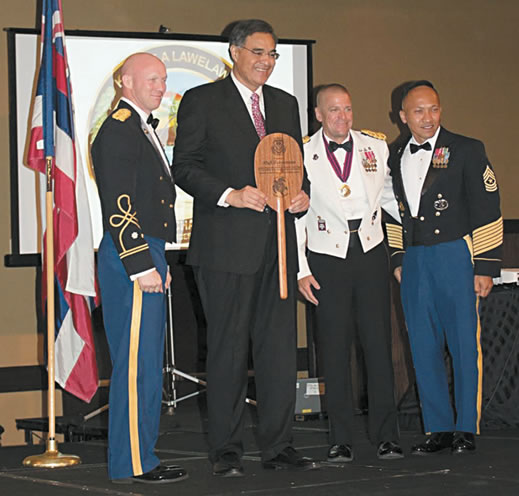Plenty Of Meaning In Military Month

The author receives a paddle of appreciation from (left to right) Lt. Col. Ed Chilton, Col. Bruce Jenkins and SGM Jon Williams
PHOTO FROM ALOHA CHAPTER AG CORPS
In 1999, Congress formally designated the month of May as National Military Appreciation Month. This act encouraged U.S. citizens to honor current and former members of the armed forces, and especially those who made the ultimate sacrifice in defense of our freedoms.
With Flag Day looming this coming Sunday on June 14, it is still appropriate to honor our military branches, especially since the American flag continues to be proudly hoisted and respectfully paraded throughout our nation and in many other parts of the world. Thus permit me to convey that, as an indication of my appreciation for the men and women of our armed
services, I was privileged recently to accept invitations to speak at two military events.
The first invitation was to the 240th-year celebration of the Army’s Adjutant General’s Corps by the Aloha Chapter of the Adjutant General’s Corps Regimental Association. Held at the Sheraton Waikiki, this was an impressive gala event. I was invited to this annual ball by a former Pacific Century Fellow, Col. Bruce D. Jenkins, chair of the Aloha Chapter. The audience consisted of military officers, NCOs and soldiers, as well as spouses and significant others. Col. Jenkins has proven to be an outstanding leader who not only commands the respect and trust of the AG Corps but of the civilian sector, in large part because of his active engagement in our community. The theme was “Citizenship” and how AG Corps officers can strive to become better leaders and citizens in our country. To this end, I was asked to share my maxims of leadership, which I have developed and honed through the years as a result of my experiences at the state, local and national level.
The AG Corps has evolved greatly since June 16, 1775, when the Continental Congress appointed Horatio Gates as the first Adjutant General making it the second-oldest existing branch of the Army. Today, the AG Corps is recognized as the Army’s Human Resources experts, and they maintain and develop Army personnel and administrative policies and programs. Now before assuming that the AG Corps is totally desk bound, as one of the officers was quick to point out, the final line of the AG Creed simply states, “I will be prepared to fight as Infantry when my commander calls.”
May was also the month selected by our government to celebrate Asian-Pacific American Heritage Month. In June 1977, U.S. Reps. Frank Horton of New York and Norman Y. Mineta of California introduced a House resolution that called upon the President to proclaim the first 10 days of May as Asian-Pacific Heritage Week. The following month, Hawaii Sens. Daniel Inouye and Spark Matsunaga introduced a similar bill in the Senate, and subsequently both were passed. On Oct. 5, 1978, President Jimmy Carter signed a joint resolution designating the annual celebration. May was chosen to commemorate the immigration of the first Japanese to the United States on May 7, 1843. It also marks the completion of the Transcontinental Railroad on May 10, 1869, whose tracks were laid in large part by Chinese immigrants. Both resolutions included Pacific Islanders that inhabit Oceania. In May 1990, the holiday was expanded further when President George H.W. Bush designated May to be Asian-Pacific American Heritage Month.
The Asian-Pacific American Heritage Month event that I was invited to was held in former cane and pine fields near Wahiawa, next to Whitmore Village, now home to the Navy’s new Hawaii Regional Security Operations Center at the Naval Computer and Telecommunications Area Master Station Pacific (NCTAMS PAC). Having never visited NCTAMS before, I was looking forward to my visit so that I could also learn what exactly occurs at their base of operations.
Greeted by NCTAMS PAC’s Executive Officer, CDR James B. Gateau, and Master Chief David Blackburn, I gave this attentive group of 21st century officers and sailors an overview of Hawaii’s relation to the Pacific and described which island groups constituted Polynesia, Micronesia and Melanesia from a historical and cultural standpoint and why along with Asia they are important to the U.S.
NCTAMS PAC has the responsibility of providing the critical shore link to more than 180 afloat units. Everything from email to and from sailors at sea in the Pacific, to orders to our nuclear submarines, go through satellite communications operated by NCTAMS PAC. As their command logo states, NCTAMS PAC is the “Pacific Voice of Command.” Also in attendance were sailors attached to the Navy Information Command Hawaii (NIOC Hawaii). NIOC personnel carry out the NSA Hawaii national mission and provide quality information warfare for the U. S. 10th Fleet,which is the fleet cyber command.
The men and women of both the Army’s local AG Corps and the Navy’s NCTAMS and NIOC Hawaii operations are extremely impressive. I was touched and pleased that they were quite aware of the issues and challenges facing Hawaii, and certainly were willing to do their part to make our state an even better place. It was an honor to meet with all of them. I left NCTAMS promising them some assistance in securing someone they very much look up to — popular Navy football head coach Ken Niumatalolo to come and visit and speak with them. He just happens to be my cousin.
Now that’s something they would really appreciate during Military Appreciation Month 2016!





